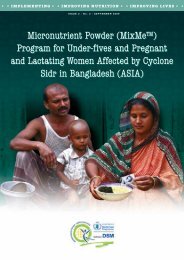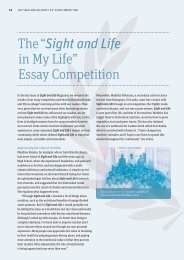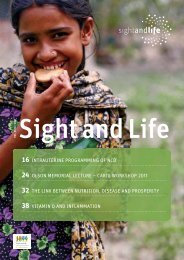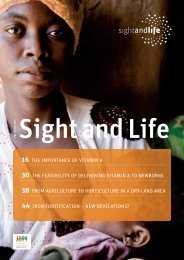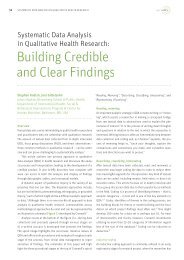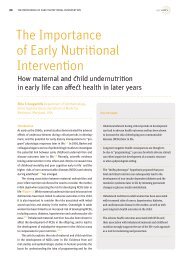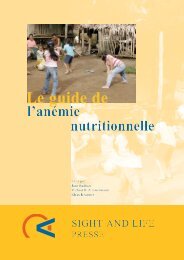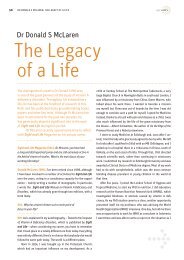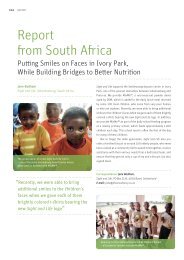Newsletter 02 2006.pdf - Sight and Life
Newsletter 02 2006.pdf - Sight and Life
Newsletter 02 2006.pdf - Sight and Life
You also want an ePaper? Increase the reach of your titles
YUMPU automatically turns print PDFs into web optimized ePapers that Google loves.
SIGHT AND LIFE 52<br />
NEWSLETTER 2/2006<br />
tion trials. It provides a synopsis<br />
of the latest research on obesity,<br />
investigating all major lines of<br />
evidence, <strong>and</strong> clarifies common<br />
misconceptions while identifying<br />
which behaviors to target <strong>and</strong><br />
which dietary factors show the<br />
most promise for prevention.<br />
CRC Press, Taylor & Francis,<br />
New York,<br />
http://taylor<strong>and</strong>francis.com<br />
Setting up <strong>and</strong> running a<br />
school garden<br />
Adequate nutrition <strong>and</strong> education<br />
are key to the development of children<br />
<strong>and</strong> their future livelihoods.<br />
The reality facing millions of children,<br />
however, is that these essentials<br />
are far from being met.<br />
A country’s future hinges on its<br />
youth. Yet children who go to<br />
school hungry cannot learn well.<br />
They have decreased physical<br />
activity, diminished cognitive abilities<br />
<strong>and</strong> reduced resistance to<br />
infections. Their school performance<br />
is often poor <strong>and</strong> they may<br />
drop out of school early. In the<br />
long term, chronic malnutrition<br />
decreases individual potential<br />
<strong>and</strong> has adverse affects on productivity,<br />
incomes <strong>and</strong> national<br />
development.<br />
Schools can make an important<br />
contribution to countries’ efforts<br />
to overcome hunger <strong>and</strong> malnutrition,<br />
<strong>and</strong> school gardens can<br />
help to improve the nutrition <strong>and</strong><br />
education of children <strong>and</strong> their<br />
families in both rural <strong>and</strong> urban<br />
areas.<br />
FAO promotes school gardens<br />
primarily as a platform for learning,<br />
as well as a vehicle for better<br />
nutrition. Schools are encouraged<br />
to create learning gardens that are<br />
moderate in size so that they can<br />
be easily managed by students,<br />
teachers <strong>and</strong> parents, but that<br />
also allow for the production of<br />
a variety of nutritious vegetables<br />
<strong>and</strong> fruits (<strong>and</strong> where possible,<br />
some small-scale livestock such<br />
as chickens or rabbits). Production<br />
methods are kept simple so<br />
that they can be easily replicated<br />
by students <strong>and</strong> parents at their<br />
homes.<br />
In preparing this manual, intended<br />
to assist school teachers, parents<br />
<strong>and</strong> the wider community, FAO<br />
has drawn upon experiences<br />
<strong>and</strong> best practices derived from<br />
school garden initiatives all over<br />
the world. Classroom lessons are<br />
linked with practical learning in<br />
the garden about nature <strong>and</strong> the<br />
environment, food production<br />
<strong>and</strong> marketing, food processing<br />
<strong>and</strong> preparation, <strong>and</strong> making<br />
healthy food choices.<br />
Setting up <strong>and</strong> running a school<br />
garden: FAO, Via Delle Terme di<br />
Caracalla, 00100 Rome, Italy<br />
Community Nutrition<br />
A new CD-ROM intended as a<br />
teaching material resource has<br />
just been produced by Teaching-aids<br />
At Low Cost (TALC), a<br />
UK-based group, with financial<br />
support by UNICEF. It contains<br />
materials from many sources<br />
around the world. Each item<br />
(mostly produced between the<br />
years 2000 <strong>and</strong> 2005) is presented<br />
with a short explanation about<br />
its use. All contributors are listed<br />
with their contact details. Among<br />
many others, the SIGHT AND<br />
LIFE CD was useful as a resource<br />
<strong>and</strong> several SIGHT AND LIFE<br />
publications, <strong>Newsletter</strong> articles<br />
<strong>and</strong> slides are included.<br />
The introduction states: “This CD-<br />
ROM ... is intended for you if you<br />
work with resources-poor communities<br />
<strong>and</strong> are training health<br />
<strong>and</strong> other types of development<br />
workers <strong>and</strong> have limited access<br />
to nutrition-related materials,<br />
particularly if you do not have<br />
access to the Internet... Nutrition<br />
is a fast-changing world – most<br />
of us have very heavy workloads<br />
<strong>and</strong> it is difficult to keep updated<br />
with recent developments.”<br />
Ann Burgess, a nutrition consultant<br />
who worked intensively on<br />
this project, commented that the<br />
contribution from SIGHT AND<br />
LIFE was very useful. At this time<br />
5000 copies are being produced.<br />
For distribution, the priority is to<br />
get copies to target users such<br />
as health practitioners <strong>and</strong> development<br />
workers in developing<br />
countries <strong>and</strong> their trainers who<br />
have limited access to nutrition<br />
materials.<br />
To request a copy of the CD please<br />
contact TALC at info@talcuk.org<br />
or visit the TALC website http://<br />
www.talcuk.org, which also gives<br />
information on other TALC nutrition<br />
related education materials.



